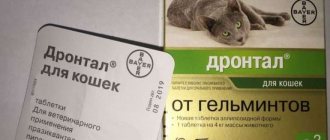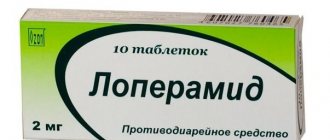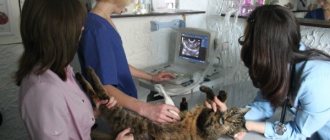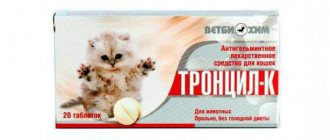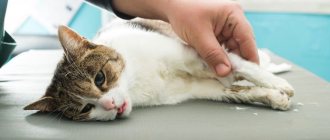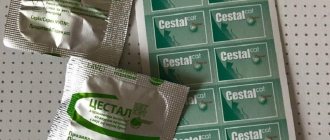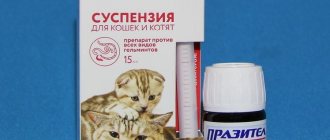Features of application
The drug Pirantel should be used only as prescribed by a veterinarian in accordance with the instructions.
Selection of dosage
The dosage of a veterinary drug should be calculated based on the weight of the animal. For 1 kilogram of cat weight, 10 mg of active substance is required.
Table: calculation of Pyrantel dosage depending on the cat’s weight
The inconvenience of the tablet form is that the required dosage is quite difficult to calculate for kittens and small animals. The suspension can be easily measured using an insulin syringe.
Reception scheme
After determining the required dosage, the drug is taken once a day for 3 days. It is highly desirable that the times of taking the medication coincide with each other. For example, if on the first day the cat was given Pirantel in the morning, then the next dose is given the next day, also in the first half of the day.
As noted above, this drug does not work at all against parasite eggs, therefore, within one course, treatment does not seem to be complete. It is recommended to repeat it after 3 weeks, that is, at a time when new individuals hatch from eggs, but do not reach the age when they themselves are able to lay eggs.
It is permissible to take Pirantel prophylactically, but only if there are indications for it. However, it is not recommended to use this drug for such purposes more than once every six months.
Can it be used in pregnant cats and kittens?
Pyrantel has a toxic effect on the animal's body, so its use during pregnancy is not recommended.
As for the treatment of kittens with Pirantel, it is only possible for those animals that weigh more than 0.5 kilograms. For them, the drug should be used in the form of a suspension.
For cats, the suspension is injected into the mouth from the side from a syringe without a needle.
Video: how to give the suspension to a kitten
How to give a pill to a cat
The Pirantel tablet has a bitter taste, so the cat will not be able to take it on its own. To do this, grind it to a powder and pour it evenly into a bowl of food.
It is important to give a small portion of food so that the animal eats it completely.
No matter how much I tried to give different tablets to cats with food, none of them would eat them, even if the tablets themselves had the smell of fish or beef. Neither raw minced meat, nor a piece of butter, nor dry food fit. Now I don't even try to give medicine that way. It is safer to put a piece of the tablet directly into your mouth and be sure that the medicine is taken in the right amount.
It is also possible to give part of the tablet to the cat as a whole. To do this, you should pick up the animal, tilt its head back a little, open the cat’s mouth and put the medicine on the root of the tongue, deeper into the throat. Your pet will reflexively swallow the medicine whole.
During this procedure, it is important to secure the cat tightly (for example, wrap it in a towel) so that it does not scratch the owner
Video: how to give a pill to a cat
What to do in case of overdose
Symptoms of an overdose of Pyrantel:
- vomit;
- loss of appetite;
- tremor of the limbs;
- apathy, lethargy;
- strong heartbeat.
In this case, the animal needs to rinse the stomach (with boiled water), give some absorbent (activated carbon) and urgently seek help from the nearest veterinary clinic.
Personal safety measures when in contact with the drug
The drug has low toxicity for humans, but it should be remembered that when working with it the following safety rules should be observed:
- carry out all manipulations with rubber gloves;
- do not allow the drug to get into the eyes and mucous membranes;
- After the procedure, wash your hands thoroughly with soap.
How does Pirantel work?
The action of the drug is aimed at damaging the muscular system of helminths by blocking nerve endings. The medicine is active against mature worms, as well as against worms in their early development. The drug has no effect on parasite larvae.
Immobilized worms are eliminated from the intestines naturally, through bowel movements.
To completely destroy intestinal worms, the medication is taken in several stages over a certain period of time.
Despite the fact that the drug is intended for people, including small children, it is quite acceptable to treat young pets with Pirantel. It is often prescribed by veterinarians for worming cats and dogs. The most important thing is to stick to the correct dosage.
If parasites are found in a cat living in the house, then antihelminthic therapy is usually recommended for the whole family. In such situations, Pirantel turns out to be a practical choice, as it is suitable for absolutely everyone: children, adults, animals.
Side effects
Even with proper treatment of your pet, the risk of side effects cannot be avoided. The most common side effect of taking Pyrantel is vomiting.
Even if this happens rarely, it still happens and it is important to be prepared for it, to show special attention to the condition of the animal after taking the medicine. You may also experience increased salivation caused by nausea.
The treated cat may appear lethargic, depressed and apathetic. There are frequent cases of diarrhea and refusal to eat.
The occurrence of an allergic reaction to any of the ingredients of the drug can be considered as a separate type of side effects. In this case, excessive itching, gastrointestinal disorders, hives on the skin and other symptoms are observed. In connection with this situation, it is necessary to stop taking the drug, begin to symptomatically eliminate the reaction, and then prescribe another one that excludes the aggressive component in the composition.
Despite the above side effects, the overall safety of this medicine meets the standards for use even in small kittens and cats with weakened immune systems. However, overly old, emaciated and emaciated animals cannot be wormed with its help.
It is also important for the owner to know that even a drug with little toxicity to the human body can cause irreparable harm to a small animal. Signs of Pyrantel poisoning should be considered a sharp increase in the cat’s heartbeat, the appearance of nausea and severe vomiting, loss of appetite and weakness, increased excitability, tremors of the limbs and a general lack of coordination of movements.
Considering the correctness of the prescribed dose and the regularity of taking the drug, cases of overdose and the occurrence of negative side reactions are quite rare. However, you still shouldn’t treat your pet yourself. It is better to entrust such an important and responsible task to a qualified specialist - a veterinarian. And if any of the above negative reactions to the drug occur, immediately go to him for additional consultation.
Contraindications and side effects
The medication is strictly prohibited for use in cats in the following cases:
- during pregnancy;
- during lactation;
- for infectious diseases;
- when exhausted;
- for severe liver and kidney diseases.
The drug is also prohibited for kittens whose weight has not reached 500 g. Do not use the medicine for kittens under 1 month of age.
Note! You should not combine the use of the drug with Piperazine, as it neutralizes its effect.
Pyrantel should not be taken together with other antiparasitic drugs. In such cases, the toxicity of the drug increases and the risk of poisoning increases.
If the recommended doses are followed, the drug is usually well tolerated by animals. Sometimes side effects occur:
- vomit;
- nausea;
- increased salivation;
- diarrhea;
- depression and apathy;
- refusal to eat.
In addition, if the components are intolerant, an allergic reaction may occur. It can manifest itself in different ways: hives, itching, redness, disturbances in the digestive system, etc. In this case, the use of the medication is discontinued, and the animal is given antihistamines and symptomatic treatment is prescribed.
Pyrantel for cats dosage
Varieties
The anthelmintic is sold in a regular human pharmacy. It comes in the form of yellow tablets or a suspension of the same shade.
Pills.
Each Pyrantel tablet contains 250 mg of active ingredient. This dose is calculated for 50 kg of weight. For dogs of small and medium breeds, a veterinarian will help determine the required amount of medication.
Suspension.
The concentration of pyrantel pamoate in the liquid form of the anthelmintic is lower, so it is chosen in cases where it is difficult to separate the tablet for dosage accuracy or there are difficulties in taking the medication in tablet form in an animal.
Since the drug contains toxic components, an overdose can cause serious consequences
It is important to accurately calculate the required dose. To do this, you can use the table:
Dog's body weight, Number of tablets, pcs.
| 1 kg | 0.04 |
| 2 kg | 0.08 |
| 3 kg | 0.06 |
| 5 kg | 0.1 |
| 10 kg | 1 tablet |
| 15 kg | 1.5 tablets |
Quantity of suspension, ml
| 1 kg | 0.2 |
| 2 kg | 0.3 |
| 3 kg | 0.4 |
| 5 kg | 0.5 |
| 10 kg | 2 ml |
| 15 kg | 3 ml |
and further at the rate of 10 mg of active substance per 1 kg of animal body weight
The medicine in any form is given in the morning feeding: with food or after food. It is more difficult to force a dog to swallow a tablet, so the liquid form is often used for treatment. The sweet taste prompts your pet to think that he is being given a treat. In case of severe infection, repeat deworming after 10 days.
Important! Dogs weighing less than 1 kg should not be given Pirantel!
Analogues of Pyrantel: composition, method of application, cost
This drug has many analogues that differ from each other in composition, method of use and cost. You cannot replace one medicine with another on your own. The decision to replace is made by the veterinarian, taking into account the clinical picture, age and weight of the four-legged patient, as well as the characteristics of his body. Information about several analogues of Pyrantel for cats:
| Drug name | Active substance | Release form | Application | Cost, rub. | |
| Method of administration | Dosages | ||||
| Pratel | Pyrantel embonate, praziquantel | Pills | Once forcibly by placing the medicine on the root of the tongue or with food. | 0.25 tablets – for kittens, 0.5 tablets – for adult animals | 436–465 |
| Drontal | Once in the morning, mixed with a small amount of food. | 1 tablet for every 4 kg of pet's weight | 291–352 | ||
| Milbemax for kittens and young cats | Milbemycin oxime, praziquantel | Once during feeding with a small amount of food or forcefully, placing it on the root of the tongue. | 0.5 and 1 tablet for kittens weighing 0.5–1 and 1–2 kg, respectively | 311–437 | |
| Milbemax for adult cats | 0.5, 1 and 1.5 tablets for adult animals weighing 2–4, 4–8 and 8–12 kg respectively | 495–685 | |||
| Dirofen | Pyrantel pamoate, praziquantel | Paste | Once during the first feeding with a small amount of food or forcefully, placing it on the root of the tongue. | 1 ml of paste for every kilogram of cat's weight | 153–195 (for adult cats) |
| Febantel, praziquantel, pyrantel pamoate | Pills | In the morning, place the medicine in a piece of minced meat, sausage or mix with porridge. The drug is used according to the following scheme:
| 1 tablet for every kilogram of body weight - for kittens, 1 tablet for every 5 kg of body weight of an adult animal | 141–175 (for cats and dogs of small and medium breeds) | |
| Pyrantel pamoate, praziquantel | Suspension | Once during the first feeding with a small amount of food or forcefully, placing it on the root of the tongue. | 20 ml of medicine for every kilogram of pet’s weight | 152–201 (for adult cats) | |
Sources
- https://usatiki.ru/pirantel-dlya-koshek/
- https://SafariCentr.ru/lyubimcy/pirantel-dlya-zhivotnyh-instrukciya-po-primeneniyu.html
- https://SetAim.ru/veterinariya/pirantel-kotu.html
- https://MurKoshka.ru/zdorovye/preparaty/pirantel-dlya-koshek.html
- https://prohvost.club/koshki/lekarstva-dlya-koshek/pirantel-dlya-koshek.html
- https://FB.ru/article/307468/preparat-pirantel-dlya-koshek-dozirovka-instruktsiya-analogi-i-otzyivyi
[collapse]
How to give a cat a deworming suspension?
First, let's figure out how to give a cat an anti-worm suspension and whether it is possible to use such a dosage form in your conditions. Let us immediately note that many cats have a frightening reaction to the suspension - foamy saliva, coughing and sneezing. If you do not take this convention into account, there are only advantages to using a suspension.
Almost always, a bottle of suspension is equipped with a dispenser. If there is no dispenser, the suspension can be given using a syringe, and to the kitten using a pipette. Before taking the suspension, hold the bottle in your palm and shake it thoroughly. By heating from the palm of your hand, the suspension mixes faster and acquires a homogeneous consistency.
Having collected the required amount of suspension, take the cat in your arms and try to calm it down. If your pet does not have a fighting temperament, you need to place it with its back to the wall (so that there is nowhere to back away), open its mouth and carefully pour the suspension onto the root of the tongue.
Irritation of the root of the tongue leads to reflex swallowing. If your pet intends to bite and scratch, it must be wrapped in a towel and held in your arms. When the cat is restricted in movement, the risk of the suspension entering the respiratory tract increases, so be very careful.
If the cat is too resistant to applying the suspension to the root of the tongue, the drug can be mixed with a small amount of food. The experience of owners shows that cats almost do not feel a deworming suspension mixed with cottage cheese or other fermented milk products.
Like any other anti-worm medications, it is recommended to give the suspension in the morning before meals. This is explained quite simply - when food is in the intestines, the rate of absorption of the drug decreases, and the maximum therapeutic effect takes longer to achieve. After administration of the drug, the cat can be fed after 1–1.5 hours, unless the instructions contain other conditions. By the way, the suspension acts quite gently, so it does not require the use of laxatives and rarely leads to disruption of the gastrointestinal tract.
The annotations of almost all suspensions indicate that the drugs have no contraindications or side effects. However, practice shows that the prevention of worms can lead to the following complications: mild apathy, nausea, increased salivation. Symptoms should be monitored, but intervention should not be made unless necessary. If the symptoms do not go away within a few hours, the cat needs to be given an adsorbent.
In rare cases, and only if there is a severe overdose, a cat can be poisoned by the deworming suspension. If you observe signs of intoxication: the cat has started vomiting, diarrhea, or the base body temperature has dropped, contact your veterinarian immediately. Adsorbents and laxatives allow for effective cleansing, since most of the active ingredients in suspensions are absorbed into the blood.
Cost of drugs
Below is a table with prices for popular drugs. The price is indicated per pack or per piece.
| Name | price |
| Albendazole | 120-400 rubles |
| Dirofen | 125-180 rubles |
| Drontal | 150-170 rubles (1 tablet), 280-340 rubles (2 tablets), 1150-1185 rubles (20 pieces) |
| Kanikquantel Plus | 99 rubles - 1872 rubles (depending on quantity) |
| Levamisole | 40-145 rubles |
| Mebendazole | 90-120 rubles |
| Milbemax | 300-479 rubles |
| Pirantel | 22-60 rubles |
| Poliverkan | 75-550 rubles |
| Prazicide | Drops - from 155 rubles, suspension - from 100 rubles, tablets - from 110 rubles |
The cost of medicines is affected by:
- quantity of anthelmintic (packaging for single use or multiple use);
- efficiency;
- the presence or absence of additional elements included with the medicine (pipette, syringe, passport stickers);
- cost of components;
- the complexity of the drug manufacturing process;
- manufacturer country.
Imported medicines are more expensive than domestic ones. However, a high price does not always indicate greater efficiency and safety. Domestic analogues are not inferior in quality to foreign ones. Also, different forms of anthelmintics cost differently. The price also depends on the packaging of the medicines. Some medicines are sold in individual form - powders, tablets. The cost in different pharmacy chains also differs. On average, the cost of anti-worm medications for kittens varies from 100 to 400 rubles.
Can pyrantel be given to dogs?
Pyrantel is used not only to rid dogs of worms, but also as a preventive anthelmintic measure. It can be used in complex therapy, combining with similar active ingredients, for example, with praziquantel to combat tapeworms, or with febantel for more effective control of whipworms (Trichuris vulpis). But often pyrantel is prescribed with oxanthelpamoate, which increases the anthelmintic effectiveness against intestinal nematodes and whipworms several times.
Pyrantel for dogs is used not only for adults, but also for puppies.
The dosage of the drug for treatment is calculated based on the body weight of the animal.
Pyrantel has two forms of release - suspension and tablets.
Indications for use
Before giving your cat this medication, you should keep in mind that it helps fight the following types of worms:
- roundworms;
- hookworms;
- trichinella;
- trichostrongylids;
- intestinal acne;
- pinworms.
Antiparasitic medication cannot fight tapeworms. It is weakly effective against whipworms, so it is better to choose other medications to combat such parasites.
Effective and popular remedies for worms
Upon detailed study of the instructions for various anthelmintic drugs, we can come to the conclusion that there are two categories of deworming tablets for cats: the first contain only one type of active ingredient, and can protect the pet from only one type of parasite. The latter have two components that effectively fight against several types of worms. They can be called complex or broad-spectrum.
The second group of drugs is quite extensive, and generally produces the same results after use. Among them, we highlight deworming tablets for cats, reviews of which are the most positive:
- Drontal;
- Pratel;
- Milbemax;
- Kanikquantel;
- Febtal;
- Dirofen;
- Polyverkan (sugar cubes);
In addition, for ease of use and dosage, anthelmintic drugs are produced in the form of a suspension (Prasitel, Dirofen, Prazicide), as well as in the form of drops on the withers (profender, inspector, advocate) and paste.
So, a list of tablets for worms with names and reviews about each.
Drontal
It is no coincidence that the drug Drontal was in first place on the list - these are deworming tablets for cats, reviews of which are more common than others. According to them, the quality and effectiveness of the drug produced in Germany is beyond doubt. The main components in it are pyrantel and praziquantel, which have a detrimental effect on round and tapeworms. The dosage of one tablet is designed for an adult cat weighing 4 kg.
It is better to give the tablet to the animal in the morning, before meals. You can feed after 1-1.5 hours. If your pet flatly refuses the tablet, you can crush it and mix it with a small amount of water, and pour it into the mouth using a syringe (without a needle!). You can also crush the tablet and mix it with a small amount of tasty cat food.
Contraindicated in kittens under three weeks of age and pregnant cats. In other cases, if the instructions are followed, it does not cause side effects or negative reactions. With the exception of situations where the pet has an individual intolerance to any components.
Milbemax
It is worth paying attention to the complex anthelmintic Milbemax. This drug has a composition different from the others: in addition to praziquantel, it contains milbemycin oxime
This chemical has a detrimental effect on roundworms living in the intestines, as well as heartworms (parasitic in the heart and blood vessels). It equally effectively affects both adult parasites and their larvae.
You can now view the current price of the drug and buy it right here:
Available in two types: for kittens and adult cats. Contraindications include: age less than 6 weeks, cat pregnancy, and animal weight less than 0.5 kg. After treatment with these deworming tablets for cats, the reviews are in most cases commendable. A positive result is achieved even after a single use.
Dirofen
Available in the form of tablets, suspension and paste. The suspension is especially convenient for determining the correct dosage for kittens - it comes with a dispenser syringe. The paste and suspension also contain pumpkin oil, which helps restore the intestines after damage by parasites.
Dirofen is a complex drug for the treatment and prevention of cestodosis and nematodosis in adult cats and kittens. The active substances are praziquantel and pyrantel pamoate, and in tablets - fenbendazole and pyrantel pamoate.
The drug has established itself as a fast-acting and effective means for deworming animals.
Contraindications and side effects
Since the drug is intended for humans, it has a number of restrictions on its use in veterinary medicine.
- It should not be used on kittens less than three weeks old;
- Not prescribed during pregnancy in females, as well as during lactation;
- Human tablets cannot be used in animals with liver failure (veterinary pyrantel - with caution);
- Hypersensitivity, allergic reaction to the main and additional components of the drug (including a history).
Pyrantel's instructions for use state that it is a safe drug with a minimum of side effects. However, sometimes phenomena such as nausea and vomiting, skin reactions, allergic reactions in the form of swelling, increased hair loss, decreased appetite, and diarrhea may occur.
Pyrantel is a synthetic active substance that has pronounced anthelmintic properties. It is used in medicine and veterinary medicine as part of complex multicomponent preparations or independently, as it is characterized by a wide spectrum of action. It is sold on the market under its own name Pirantel (currently quite rare), as well as under the trade name Biltricide. Included in veterinary drugs.
Also analogues are:
- Helminthox;
- Nemocid;
- Pyrantela pamoate.
Instructions for use characterize the drug as an effective broad-spectrum remedy. After two doses of the active substance, complete cure occurs in 98-100% of patients.
The main active ingredient of the drug is pyrantel pamoate. The following are used as auxiliary components:
- starch;
- talc;
- gelatin;
- magnesium stearate;
- propylparaben;
- calcium gluconate;
- silica.
| Medicine | Active substance | Mechanism of action | Price |
| Pirantel | Pyrantela pamoate | Paralytic effect on the muscle fibers of the parasite through depression of the nervous system | From 30 to 60 rubles |
| Pratel | Pyrantel embonate; praziquantel | Paralysis of the parasite's muscles and its subsequent death | From 40 to 70 rubles |
| Drontal | Pyrantel embonate | Paralytic effect on the parasite and its death | From 80 to 120 rubles |
| Milbemax | Milbemycin oxime; praziquantel | Destruction of the worm shell and muscle fibers, leading to death | From 400 to 600 rubles |
| Dirofen | Fenbendazole, pyrantel pamoate | Persistent depolarization of muscle structures, disruption of energy metabolism and subsequent death | From 100 to 180 rubles |
Instructions for use
Dosage
The dosage is calculated at 10 mg of pyrantel per kg of body weight for puppies and small dogs. If the animal's weight exceeds 2.5 kg, it is recommended to give 5-10 mg of the active substance per kg of the dog's weight. After treatment of the disease in a severe stage, re-therapy should be carried out ten days later.
Important! 5-10 mg per kilogram of animal weight is a generally accepted recommendation. However, in the instructions for veterinary drugs you can find dosages at which the active component is obtained several times more. This is most likely explained by the lower quality of the active component, since in the medicine it is present in the form of a salt, the concentration of which can be different, or simply errors in calculations for reinsurance
This is most likely explained by the lower quality of the active component, since it is present in the medicine in the form of a salt, the concentration of which may be different, or simply by errors in calculations for reinsurance.
Although the drug is considered quite safe, the puppy’s body is not yet strong, and incorrect dosages can harm it. Therefore, it is strongly recommended that you consult your veterinarian first.
How to give tablets?
Doctors insist that before using the drug it is necessary to feed the animal. If it is difficult to administer a pure drug to a puppy, it can be added to any food, either in the form of a suspension or in the form of a tablet crushed to powder.
When using the drug in tablet form, it is best to place it under the animal's tongue, and then pick it up and scratch it under the neck. This will trigger the swallow reflex, which will help your puppy swallow the medicine quickly.
The drug has two main forms: tablets containing 0.25 g of the active ingredient, and suspensions of 20 ml. For diseases such as ascariasis and enterobiasis, it is enough to give the medicine once a day, regardless of the weight of the animal.
If many parasites are detected at the same time, the dosage may be increased. In this case, therapy should last at least three days. Also, the dosage should be increased in severe forms of a disease such as necatoriasis. It is optimal to give the medicine in the morning.
Children's suspension
It is better to administer the suspension to puppies into the mouth using a special syringe. The liquid is squeezed into the throat. This way the animal will receive the maximum of the active component.
It is worth considering that pyrantel has a detrimental effect only on sexually mature parasites, and does not affect their eggs and larvae. Therefore, having carried out treatment for the first time, after a certain period (about 2-3 weeks) it is better to repeat it and make sure that there are no worms. When treating severe stages of disease, a third course may be indicated.
Important! The drug has contraindications. These include pregnancy and feeding puppies, intolerance to components, chronic diseases of the genitourinary system, as well as reduced activity of the animal’s liver.. The drug provokes side effects extremely rarely
The following may appear:
The drug causes side effects extremely rarely. The following may appear:
- the appearance of itching and rash;
- nausea and vomiting;
- increased drowsiness;
- temperature increase;
- convulsions.
In practice, such phenomena occur in one dog out of a hundred.
Pharmacokinetics
After oral administration (swallowing), Pyrantel is poorly absorbed from the cat's intestines. This ensures that, with relatively little toxicity, high concentrations of the drug reach the large intestine and kill the helminths localized there.
Absorbed Pyrantel is rapidly metabolized in the liver. In cats, 40% of the administered dose is excreted in the urine, mostly unchanged.
Dosage
Veterinary medications for cats containing pyrantel pamoate are accompanied by instructions and the dosage should be taken strictly from it or as prescribed by a veterinarian. This is because these tablets or pastes usually contain at least one other active ingredient to broaden the spectrum of action, such as praziquantel. In this case, the principle of dosage calculation changes.
But many owners prefer to use pyrantel from a regular pharmacy (for humans), which makes it more likely to get a quality product. It is available in the form of tablets and suspension. Regardless of the form, it is dosed to cats from 5 to 10 mg/kg once, while a larger dosage is especially advisable for kittens. Treatment is repeated after three weeks. The drug should not be administered without first consulting a veterinarian.
Please note that the dosage of pyrantel from a regular pharmacy for cats is indicated not based on the amount of the drug itself, but on the active substance. Moreover, one tablet of pure pyrantel salt usually contains 250 mg, and in a suspension - 50 mg per 1 ml. But there may be other ratios, depending on the manufacturer.
As a result, for cats you need approximately:
| Cat body weight | Minimum required dose of pyrantel, mg | Amount of suspension from a regular pharmacy, ml* | Number of tablets from a regular pharmacy (250 mg of active substance) |
| 600 g (average weight of a kitten at first deworming) | 3 | 0,06 | 0,012 |
| 1 kg | 5 | 0,1 | 0,02 |
| 2 kg | 10 | 0,2 | 0,04 |
| 3 kg | 15 | 0,3 | 0,06 |
| 4 kg | 20 | 0,4 | 0,08 |
| 5 kg | 25 | 0,5 | 0,1 |
One milliliter of suspension is usually equal to 50 mg of pyrantel, which was taken as the calculation in the table. But sometimes it's less.
Why is prevention of worms in cats important?
Absolutely all cats are susceptible to infection with worms. The infestation can cause serious health problems, especially if it is ignored for a long time. The best way to prevent serious negative consequences is the prevention of worms in cats.
You can protect your pet from parasites by taking care of decent living conditions:
- Don't let your cat go for a walk unattended.
- Make sure your pet does not come into contact with stray animals.
- Keep your home clean.
- Regularly carry out preventive measures to eliminate parasites.
Let's look a little more closely. The main source of helminth infection is food and water. If your cat is outdoors, she may prey on rodents and birds. In addition, a cat only needs to smell a dead animal to pick up fleas or worms.
Dirofilariasis is a dangerous, fatal disease caused by worms that parasitize the heart. If you live in an unfavorable area, carry out monthly prevention of dirofilariasis infection. Naturally, before using any medications, you should consult your doctor.
Protect your cat from walking outside unattended in every possible way. When a pet is walking, it can drink water from a puddle - this is a guaranteed route of infection with worms. In addition to the dangers posed by people and other animals, a free-roaming cat is constantly exposed to the threat of infection by internal and external parasites.
If there are several animals living in the house, the health of each pet must be monitored individually. If one of the animals shows signs of illness, it must be isolated.
Due to the rapid spread of some viruses and parasites, protect your pets in every possible way from contact with stray animals. If you pet a street cat or dog, treat your hands with antiseptic or wash them when you get home. Oddly enough, in most cases, cats become infected with worms from the owner’s things and hands.
Like humans, cats have some resistance (resistance) to worm infection. Most often, the infestation does not reach a critical level if the cat’s immunity functions normally.
If the pet feels weakened, the worms will “take advantage” of this and begin to reproduce much faster. Consult your veterinarian about choosing food or creating a diet that has a positive effect on immunity.
How to determine if a cat has worms at home
The most reliable way to determine parasites in a pet is a stool test. To collect a sample, place a small amount of feces in a plastic or glass container while cleaning the tray. The sample is submitted to a laboratory, whose workers will determine the presence of eggs of different types of helminths. After cleaning the tray, be sure to wash your hands, since direct contact with feces is a guaranteed route of infection with worms.
If your indoor cat has fleas, you can guarantee that she also has worms. Regularly prevent skin parasites, since they are carriers of cestodes - flatworms. For your own convenience, you can purchase a complex drug in the form of drops at a veterinary pharmacy, which helps to instantly rid your cat of external and internal parasites.
Infection with worms may be indicated by changes in the functioning of the gastrointestinal tract. You can identify the following symptoms at home:
- Diarrhea, especially when mixed with blood.
- Vomiting and nausea.
- Bloating and flatulence.
- Frequent licking of the genitals, itching in the anal area.
- Cough and other breathing problems
How often to prevent worms
How often should preventive measures be taken to eliminate worms in cats? According to generally accepted rules, prevention is carried out quarterly, that is, once every three to four months. It is believed that a period of 4 months is enough for helminths to multiply to a critical number.
Prevention of dirofilariasis and other specific infestations is carried out monthly or as prescribed by a veterinarian.
It has been established that parasites become much more active in the spring and autumn. If your pet is about to have his first anthelmintic treatment, it is best to do it in February-March or September-October. Do not forget that you yourself may be the source of parasite infection. Don't ignore preventative care for yourself and your family.
Types of worms found in cats
Helminthiasis is a group of diseases caused by helminths (worms). The type of helminthiasis depends on which parasite has entered the body:
- Roundworms (nematodes). They live in the small and large intestines and feed on the blood of the carrier, therefore they cause anemia, but can cause general intoxication of the body or lead to allergies. A sick pet may experience bouts of vomiting blood, bloating, and possible sudden weight loss.
- Tapeworms (cestodes). The most common tapeworms of this species include cucumber tapeworm and echinococcus, which live in the stomach. The cucumber tapeworm is dangerous due to its size (in cats it usually grows up to half a meter). As it grows, it can damage the walls of the gastrointestinal tract. Echinococci are more dangerous for both domestic animals and humans. Their intermediate form develops in any organ of the host, causing damage.
- Trematodes (flukes). These worms parasitize the bile ducts of the liver (sometimes the pancreas), but their larvae can infect the intestines, lungs, or other organs. Therefore, the symptoms of the disease may vary.
Symptoms of helminthic infestation in a cat
Signs of helminth infection may include the following symptoms:
- loose stools;
- constipation;
- alternating loose stools and episodes of difficulty defecating;
- vomiting - sometimes even with blood and worms;
- in feces and on the hair around the anus - fragments of helminths or whole individuals;
- “riding” on the butt caused by itching;
- stool mixed with bloody and mucous components;
- bloated belly;
- weight loss;
- loss of appetite or uncontrollable bouts of gluttony;
- cough;
- difficulty breathing;
- pathological shedding;
- growth retardation in kittens;
- increased fatigue;
- icterus (yellowness) of the mucous membranes, sometimes their pale color (with anemia);
- convulsive syndrome and paralysis of the hind legs;
- spontaneous abortion of embryos or untimely birth.
You just need to keep in mind: if you have not visually confirmed the presence of parasites in your pet, similar symptoms may accompany other diseases. Treatment for deworming that is not supervised by a veterinarian can worsen the health of your pet. Before using medications, it is advisable to undergo tests and consult with specialists.
What worms are found in both cats and people?
Parasites are divided into 3 large groups: cestodes, trematodes and nematodes. Most often, roundworms are found in representatives of the cat family: hookworms, toxascarids, toxocaras, trichinella, roundworms, etc. Less often, they show signs of the presence of tapeworms (tapeworms, cucumber tapeworms, alveococci, Mesocestoides lineatus, Hydatigera taeniaformis) and flat flukes ( pulmonary flukes, opisthorchis, cat flukes, Pseudamphistomum truncatum, Metorchis bilis, Euparyphium melis).
Use in cats and dogs
Many owners have questions about whether this medication can be given to cats, as they have significant restrictions on treatment with certain types of human anthelmintics. If Pirantel is given to a cat in a correctly calculated dosage and in accordance with the instructions, then with a single treatment it will not cause harm. For systematic treatment and prevention, it is necessary to use veterinary drugs.
The dosage for cats is calculated as 5 mg per 1 kg of animal body weight. An adult cat is given approximately half a tablet, a kitten - a quarter of a tablet. If a suspension is given, then an adult cat needs to drink 2.5 ml of the drug (half a measuring spoon), and a kitten needs a quarter of a measuring spoon.
It is better to take the drug an hour after eating so that the animal does not vomit, especially when the drug is soldered by force. After 10 days, you need to take it again in the same dosage (if the animal’s weight has not changed). This will help reduce the likelihood of re-infestation.
The dosage for dogs is calculated, as for cats, by weight. Animals weighing more than 2.5 kg are given 5-10 mg of the drug per 1 kg of weight. For puppies, the dosage is 10 mg per 1 kg of animal body weight. The same amount can be given to dogs whose weight is less than 2.5 kg; then, as in the case of cats, the medicine is given once, but after 10 days the dose must be repeated in the same dosage (with the same weight) for prevention.
Composition and release form
The active principle is pyrantelapamoate. The drug may contain various excipients, depending on the manufacturer: starch, gum arabic (gum arabic), methylparaben, gelatin, propylparaben, calcium gluconate, magnesium stearate, talc, colloidal silicon dioxide. As a rule, these substances are designed to bind the active principle and are used as a filler. Some of them, such as colloidal silicon dioxide, help to “capture” and remove toxins from the animal’s gastrointestinal tract while being gentle on the intestinal epithelium.
Three large groups of worms are called worms - trematodes, cestodes, nematodes
The drug is available in the form of yellow tablets, with a division line, uncoated, and a suspension, a yellow oily liquid with a specific odor. If you purchase a suspension of pyrantel at a medical pharmacy, then it is possible that there will be an aromatic additive, for example, apricot, which your animal may not like.
One tablet contains 250 mg of active ingredient.
Every five ml of suspension also contains 250 mg of active ingredient. During storage, the suspension may separate into layers, so shake it before use.
Dosage forms
"Pyrantel" can be found both in suspension and tablets.
It is more convenient for humans to use the tablet form. One package is enough to cope with infection by roundworms, pinworms, hookworms and nematodes. One tablet contains 250 mg of the active substance - pyrantel pamoate. Three are enough, which are drunk by an adult of average parameters at the same time. The dose depends on the individual's body weight.
The drug also contains lactose, talc, magnesium stearate, microcrystalline cellulose and silicon dioxide. How to give Pirantel suspension to a cat? Exclusively in the form of a suspension, since 1 ml of the substance contains less active substance - only 50 mg. This is important for the correct dosage, since the weight of the animal is significantly less than the weight of the human body.
